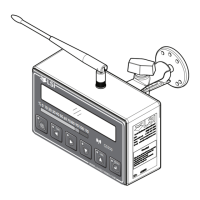2. Operation 37
2. Press Enter twice to go to the sensor list (4A1).
3. Press Next repeatedly to advance to the next available sensor position, usually follow-
ing the four load sensors and the sum load sensor.
4. The id can be left at 0, press Next.
5. The sensor type should flash; use Up and Down to select the sensor type Imbalance
sensor. Only one imbalance sensor is required to calculate imbalance for all four load
sensors.
6. Press Enter to save any changes.
7. Press Exit three times to return to the operation display.
8. Confirm the imbalance factor limit and the imbalance minimum limit in the limit menu.
Examples:
Imbalance factor calculation for load sensor № 1
Load № 1 Imbalance Factor = 100 X
Average (Load 2, 3, and 4) – Load 1
Average (Load 2, 3, and 4)
If the imbalance factor limit is 15%, then the system is safe.
A 7500 B 8100
C 8000 D 8200
Load № 1 (A) Imbalance Factor = 100 X
8100 – 7500
8100
= 7.5 %
If the imbalance factor limit is 15%, then an imbalance alarm is generated.
A 6800 B 8100
C 8000 D 8200
Load № 1 (A) Imbalance Factor = 100 X
8100 – 6800
8100
= 16 %
2.8.3 Slack Rope
Systems programmed for four load sensors and four load sum indication can be programmed with
a slack rope sensor to warn against unwanted rope payout when the load touches down.
Slack rope minimum limit. The slack rope sensor compares the sum load to an adjustable
slack rope minimum limit. When the sum load goes below the slack rope limit a slack rope
alarm is generated. The slack rope limit is usually adjusted to less than the weight of all rig-
ging below the load sensors. The default slack rope minimum limit for is 1000 (pounds or
kilograms depending on load display units).
Program the slack rope sensor.
1. Press Menu, and then Next three times.
2. Press Enter twice to go to the sensor list, menu page 4A1.
3. Press Next repeatedly to advance to the next available sensor position, usually follow-
ing the four load sensors, the sum load sensor and the imbalance sensor.
4. The id can be left at 0, press Next.

